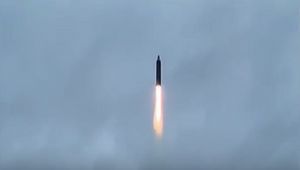North Korea is clearly getting quite good at long-range missile engineering. It’s Hwasong-12 and Hwasong-14 missiles have made that clear this year with their multiple successful flight tests, demonstrating what is by far the best-performing family of missiles North Korea has ever flight-tested.
Despite this, several observers refuse to believe that North Korea could have achieved this level of performance primarily through indigenous research-and-development. In August, we saw reports that alleged that the RD-250-variant engine that sits at the heart of both missiles’ first stage was likely stolen or imported illicitly from the former Soviet Union.
The U.S. intelligence community quickly pushed back at that idea. As I discussed here in The Diplomat, while the provenance of the design of those engines is indeed Soviet, the units North Korea has been building missiles around were the result of domestic engineering ingenuity and iteration—perhaps with a small helping hand from Tehran.
Along similar lines, a New York Times report weeks ago tried to suggest that the advanced hypergolic liquid rocket propellants at the heart of North Korea’s two new liquid-fueled missiles (and last year’s 4D10-engine-based Musudan) were being imported from either Russia or China—two countries with close ties to North Korea that produce these fuels in massive quantities.
Of course, this is simply just not the case. Despite its suggestive lede that North Korea’s hypergolic propellants “initially came from China and Russia,” the Times story also noted that U.S. “intelligence officials believe that the North’s program has advanced to the point where it is no longer as reliant on outside suppliers, and that it may itself be making the potent fuel, known as UDMH.”
This week, also over at the New York Times, Max Fisher reports on a new open-source research finding from the always-excellent team at the James Martin Center for Nonproliferation Studies that makes clear that North Korea is likely not dependent on imports of these propellants—mainly a highly volatile hypergolic fuel known as unsymmetrical di-methyl-hydrazine.
In fact, North Korea is almost certainly manufacturing this fuel—one half of the propellant combination that makes Hwasongs 12 and 14 go zoom—right at home, in a known chemical plant that is publicly known to have some commercial applications in synthetic textile manufacturing, but that evidence suggests is the site of more nefarious missile-related activities. (Dig deep into the findings here.)
None of this should be a source of shock or surprise. North Korea, under years of sanctions and isolation, has channeled a disproportionate amount of its economic and intellectual energies toward realizing its nuclear weapons and ballistic missile programs. If there’s anything 2017 has made clear to the world, it’s that those efforts paid off.
Given the centrality of these programs to the Kim regime’s survival strategy, it’s laughable that Pyongyang would have left itself vulnerable to a sudden export cut-off of hypergolic propellants from fickle overseas partners. Even if it was buying these propellants on the black market—an unlikely proposition simply given the immense volatility of UDMH—there’s nothing quite like domestic manufacturing.
Even leaving aside the evidence uncovered by the Monterey researchers, North Korea has had engines like the 4D10 at the heart of its older BM-25-based Musudan ballistic missile for decades.
That engine uses the same UDMH-based hypergolic propellant combination. You’d think that over that period of time, North Korea would have at least figured out the frankly archaic chemistry behind a substance like UDMH. (Even if the chemistry is archaic, it’s not a fun weekend backyard project given the immense volatility and danger of handling UDMH.)
Finally, the frequent pace of testing of its new liquid-fueled ballistic missiles—each of which guzzles gallons of UDMH—should suggest that North Korea doesn’t feel itself to be constrained by materials at this point. Repeated testing of the Hwasong-12, Hwasong-14, and the Musudan last year is a fairly good indicator of their confidence that they won’t run out of UDMH to make these missiles fly for research-and-development purposes.
With everything we’ve seen out of North Korea this year, we should both stop being surprised when they demonstrate increasingly more impressive capabilities and also stop underestimating the extent of their knowhow. In the end, Juche, the ideology of self-reliance at the core of the North Korean project since the founding of country, is there for more than just show.

































